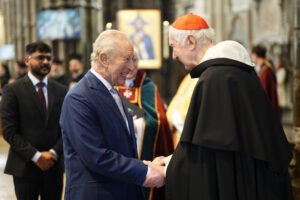The Last Day of Lent: Understanding Holy Thursday, Good Friday, and Easter Sunday 2025
Introduction to Lent and its Significance
Lent is a profound season observed within the Christian faith, marking a period of preparation, sacrifice, and reflection leading up to the celebration of Easter. This solemn time lasts for forty days, beginning on Ash Wednesday and culminating on Holy Saturday, the day before Easter Sunday. The origin of Lent can be traced back to the early church, where it was established as a time for believers to spiritually prepare for the resurrection of Jesus Christ. It serves not only as a reminder of the trials and suffering faced by Christ but also as an opportunity for personal renewal and growth in one’s faith.
The central theme during Lent revolves around the concepts of sacrifice and self-denial, mirroring the sacrifices made by Jesus. Many Christians observe this period by engaging in practices such as fasting, prayer, and almsgiving, which serve as pivotal elements in fostering a deeper relationship with God. Each individual’s approach to Lent may differ; some may choose to give up specific luxuries or habits, while others might prioritize acts of kindness and charity toward the less fortunate. This period of introspection aids in reinforcing the values of empathy and compassion, uplifting the spiritual essence of the community.
As Lent progresses, the focus intensifies as believers prepare for the significant events of Holy Thursday and Good Friday, commemorating the Last Supper and the crucifixion of Jesus, respectively. This journey transforms the observational stance into an immersive experience, allowing for deeper engagement with the core tenets of Christianity. Ultimately, Lent serves as a spiritual journey, inviting each participant to reflect on their own life, align their actions with their faith, and anticipate the joyous celebration of Easter Sunday. Through this preparation, Lent cultivates a sense of renewal and hope as believers look forward to the resurrection of Jesus and the promise of eternal life.
The Importance of Holy Thursday
Holy Thursday, often referred to as Maundy Thursday, holds significant importance within Christian traditions. Observed on the Thursday before Easter Sunday, this day commemorates the Last Supper, which was the final meal Jesus shared with His disciples before His crucifixion. This moment is crucial in Christian theology as it emphasizes the themes of sacrifice, service, and communion, key elements that resonate throughout the Passion narrative.
One of the profound rituals associated with Holy Thursday is the foot washing ceremony, a poignant symbol of humility and service. During the Last Supper, Jesus washed the feet of His disciples, demonstrating that true leadership is rooted in serving others. This act of foot washing is not merely a historical recollection but serves as a reminder for believers to embody the values of love and servitude in their daily lives. It teaches the importance of humility and the call to serve one another, which is particularly emphasized in the Christian faith.
Additionally, Holy Thursday is significant for the institution of the Eucharist. During the Last Supper, Jesus established the sacrament of Communion, inviting His followers to partake in His body and blood, symbolizing His impending sacrifice for humanity. This institution is pivotal, as it establishes a fundamental rite within Christianity, known as the Holy Communion or the Lord’s Supper, which reconnects believers with the core of their faith through remembrance and participation in the divine mystery of Christ’s sacrifice.
Many congregations engage in special services on Holy Thursday, often featuring the reenactment of the Last Supper and the foot washing ritual. These observances create a deeper emotional and spiritual connection for the faithful, allowing them to reflect on Jesus’s final teachings and His ultimate sacrifice. Thus, Holy Thursday serves as a vital precursor to the solemn observances of Good Friday and the joyous celebration of Easter Sunday, enriching the Lenten journey for many believers.
Understanding Good Friday
Good Friday, observed on the Friday before Easter Sunday, is a pivotal date in the Christian liturgical calendar, as it commemorates the crucifixion of Jesus Christ. This solemn day is not merely a historical observation but a profound reflection on the themes of sacrifice and redemption central to Christian belief. The events of Good Friday mark the culmination of the Passion narrative, emphasizing the suffering endured by Jesus for humanity’s salvation. It serves as a day of mourning, symbolizing the weight of sin and the depth of divine love manifested through Jesus’ ultimate sacrifice.
The theological implications of this observance are significant. Good Friday embodies the concept of redemption, highlighting that through Christ’s suffering and death, believers gain forgiveness and reconciliation with God. This day invites Christians to meditate on the gravity of sin and the immense cost of grace. As congregants gather for worship, the mood is characterized by a profound sense of reverence and contemplation, with many reflecting on the sufferings of Christ as a means to foster a deeper understanding of His love and mercy.
Traditionally, observances on Good Friday include fasting and participating in services that focus on the Passion narrative. Many Christians engage in the veneration of the cross, acknowledging the instrument of Jesus’ crucifixion as a sign of hope and redemption. Rituals may include the reading of scriptures, singing hymns, and prayers that cultivate an atmosphere of penitence. The somber nature of this day flows into the larger narrative of the Easter season, setting the stage for the triumphant resurrection celebrated on Easter Sunday. This juxtaposition of sorrow and joy is vital in comprehending the full impact of the Easter story, creating an integral part of the Christian faith journey.
The Celebration of Easter Sunday
Easter Sunday holds profound significance within the Christian faith, representing the resurrection of Jesus Christ from the dead. This pivotal event, occurring after the solemn observances of Holy Thursday and Good Friday, symbolizes hope, renewal, and the ultimate victory over sin and death. The resurrection is not merely a historical occurrence; it forms the cornerstone of Christian belief, providing followers with the assurance of eternal life and the promise of salvation.
The themes of Easter Sunday extend beyond the mere commemoration of Jesus’s triumph over death. They resonate with the experiences of believers, reflecting the transformative power of faith in overcoming personal challenges and struggles. As Christians gather to celebrate this joyous occasion, they engage in meaningful rituals and traditions that connect them to their faith and to one another.
One prevalent custom associated with Easter Sunday is the sunrise service, an early morning gathering that symbolizes the discovery of the empty tomb. This tradition emphasizes the light breaking through darkness, representing both spiritual awakening and physical resurrection. Attendees often come together to sing hymns, read scripture, and share in reflective prayers, fostering a sense of community and shared faith.
Additionally, feasts and communal meals form another important aspect of Easter celebrations. Families and friends unite to enjoy special dishes and treats, signifying abundance and the joy of the season. The meal itself serves as an occasion for fellowship, reinforcing relationships and nurturing a sense of belonging within the faith community.
The Easter egg is yet another powerful symbol of the holiday. Often decorated and exchanged, eggs represent new life and rebirth, aligning perfectly with the message of resurrection. As such, they serve as a visual reminder of the renewed life that Christians believe comes through faith in Jesus Christ.
Ultimately, Easter Sunday is not only a day of celebration; it encapsulates the essence of Christian faith—hope, renewal, and victory—inviting believers to reflect on their spiritual journey and the profound implications of resurrection in their everyday lives.
Lent’s Conclusion: Transition to Easter
The culmination of Lent serves as a profound transition into the joyous celebration of Easter, signifying a pivotal moment in the Christian liturgical calendar. As Christians reflect on the themes of sacrifice, penance, and spiritual renewal throughout the Lenten season, the final days of this period lead directly into the vibrant celebrations of Easter. This transition is especially highlighted during Holy Thursday and Good Friday, which not only commemorate pivotal events in the life of Jesus Christ but also provide a deep theological backdrop for the subsequent joy of Easter Sunday.
Holy Thursday, also known as Maundy Thursday, marks the Last Supper of Jesus with His disciples, during which He instituted the Eucharist. This liturgical observance lays the groundwork for the transition from Lent to Easter, emphasizing themes of service, humility, and love. The washing of the feet, a tradition observed in many Christian denominations, symbolizes the call to serve one another, reflecting the essence of Jesus’ teachings. Furthermore, the services held on this day prepare the faithful for the solemn events of Good Friday, creating an atmosphere of contemplation and remembrance.
Good Friday follows closely, commemorating the crucifixion of Christ. It is a day marked by mourning and reflection, where Christians engage in solemn services that often involve veneration of the cross, fasting, and prayers. The emotional weight of this day serves as a stark reminder of the sacrifices made for humanity’s redemption and an invitation for believers to contemplate their own faith journeys.
As Lent closes, the transition to the Easter Vigil on Saturday evening represents a profound leap into rejoicing and celebration. This vigil is filled with rich liturgical traditions, including the lighting of the Paschal candle, baptismal rites, and the renewal of baptismal promises, symbolizing the resurrection of Christ and the triumph of life over death. The movement from Lent’s introspection to the exuberance of Easter encapsulates the core of the Christian faith: hope, renewal, and the promise of eternal life.
Cultural Traditions Surrounding Lent and Easter
The period of Lent leading to Easter is marked by a rich tapestry of cultural traditions that vary widely across different regions and Christian denominations. These customs are not only significant in religious observance but also serve as a means for communities to come together and strengthen their bonds. One of the most recognized practices during Lent is fasting, which serves as a form of spiritual discipline intended to enhance one’s relationship with God. Many cultures have specific fasting guidelines, reflecting their unique interpretations of this tradition. For instance, some may abstain from meat or certain foods, while others embrace a complete fast. This variation highlights the diverse expressions of faith and devotion during this holy season.
In addition to fasting, almsgiving plays a critical role in many cultures. The act of giving to those in need is a fundamental aspect of Lent, encouraging individuals to reflect on their blessings and share with the less fortunate. Various religious and charitable organizations often organize community initiatives, allowing congregations to actively participate in service projects or fundraising events. Such collective efforts can strengthen community ties and promote a sense of shared purpose within the faith community.
Festive meals also mark the transition from the solemnity of Lent to the joyous celebration of Easter. Families and communities frequently gather for shared meals, featuring traditional dishes that vary by culture. For example, Italian communities may prepare a feast of baked goods and sweet treats, while Eastern European customs include dishes symbolizing rebirth and renewal. These communal gatherings not only offer nourishment but also create opportunities for socializing and fellowship, reinforcing the themes of unity and celebration inherent in the Easter season.
Overall, the cultural traditions surrounding Lent and Easter illuminate how diverse practices can enhance the spiritual experience of this season, promoting a deeper understanding of its significance within the Christian faith.
Spiritual Reflections for Lent and Easter 2025
The period of Lent leading to Easter is a profound opportunity for spiritual reflection and renewal. This season, observed by many Christians, offers a time to deepen one’s faith through prayer, meditation, and meaningful activities. Engaging in these practices can foster personal growth and a more profound connection with the divine. As believers embark on this journey, unity and compassion stand out as essential themes to embrace throughout the Lenten season and into Easter 2025.
One recommended practice is to set aside a specific time daily for prayer. This can be complemented by focusing on gratitude, where individuals can take a moment each day to reflect on blessings in their lives. Journaling these thoughts can serve as a powerful tool for personal reflection, helping to cultivate a heart of thanksgiving and awareness of God’s presence. Meditative practices such as contemplative prayer can also enhance this experience, allowing one to listen for divine guidance and wisdom.
In addition to private prayer, participating in community activities is vital. Engaging in acts of kindness, volunteering, or simply reaching out to help a neighbor fosters a spirit of compassion that is essential during this reflective period. Unity can also be strengthened through shared community events or church services, encouraging collective worship, and deepening connections with others in faith. Activities like contributing to food drives or organizing service projects can serve as tangible expressions of love and care.
Finally, it is essential to approach Easter, the culmination of this sacred time, with a spirit of renewal. Allowing oneself to move forward with hope and joy is crucial. Taking part in Easter celebrations can reignite one’s faith and create lasting memories that resonate throughout the year. As Lent concludes, let us strive for a deeper understanding of our spiritual journey, embracing unity, compassion, and renewal as guiding principles in our lives.
Community Celebrations and Events for Easter 2025
Easter 2025 presents a unique opportunity for communities to come together and celebrate this significant occasion. Various churches and local organizations have planned an array of events to mark the culmination of the Lenten season. These scheduled activities not only aim to provide spiritual enrichment but also foster communal ties among residents, thereby enhancing the overall experience of Easter.
Many churches will hold special services leading up to Easter Sunday, including Holy Thursday and Good Friday observances. These services often feature traditional liturgy, music, and specific rituals that highlight the significance of the Passion and Resurrection of Christ. In 2025, it is expected that congregations will host collaborative services, inviting members from different denominations to join in unity and reflection. Such joint gatherings not only bolster the spiritual essence of the occasion but also encourage dialogue and foster inter-community relationships.
In addition to church services, various outreach events are planned as well. Community members may participate in volunteering opportunities, assisting local charities or organizing food drives to support those in need during this festive time. These activities serve to embody the values of compassion and generosity that are central to the Easter message, ensuring that the joy of this season extends beyond the church walls.
Family-oriented activities will also play a pivotal role in community celebrations, with events such as Easter egg hunts, craft fairs, and intergenerational picnics anticipated in many neighborhoods. These gatherings allow families to connect, share traditions, and create lasting memories together. Ultimately, the collaborative efforts of churches and local organizations pave the way for a vibrant and meaningful Easter celebration, reinforcing the fabric of community life during this revered holiday.
Conclusion: Embracing the Journey from Lent to Easter
The transition from the solemnity of Lent to the joy of Easter is more than just a chronological progression; it represents a profound spiritual journey that prompts personal reflection and growth. This period begins with Holy Thursday, where the Last Supper commemorates the establishment of the Eucharist and the call to service exemplified by Jesus washing the disciples’ feet. This occasion encourages individuals to remember the importance of community and selflessness in their spiritual lives.
As we move into Good Friday, the atmosphere shifts dramatically to that of mourning and penitence. The crucifixion of Jesus ultimately highlights themes of sacrifice and redemption. Acknowledging the weight of this somber day allows believers to confront their own imperfections and understand the depth of divine love manifested through suffering. Good Friday is a call to contemplate the significance of Jesus’ sacrifice, urging followers to recognize the path to salvation that emerges from this dark chapter.
The culmination of this journey is Easter Sunday, a day of triumph and renewal. It celebrates the resurrection of Christ, symbolizing hope and the promise of eternal life. This moment invites individuals to embrace the joy and optimism that faith brings, encouraging them to live a life characterized by resilience and love. Easter thus becomes not merely a holiday but a transformative experience that reinforces the core tenets of Christianity.
As individuals reflect on the significance of these pivotal days, it is vital to approach this journey with an open heart and mind. Engaging with the lessons of Holy Thursday, Good Friday, and Easter Sunday fosters a richer understanding of faith. This holistic embrace of the journey from Lent to Easter can indeed impact one’s spiritual life, encouraging deeper connections within oneself, the community, and the divine.










Leave a Reply
You must be logged in to post a comment.